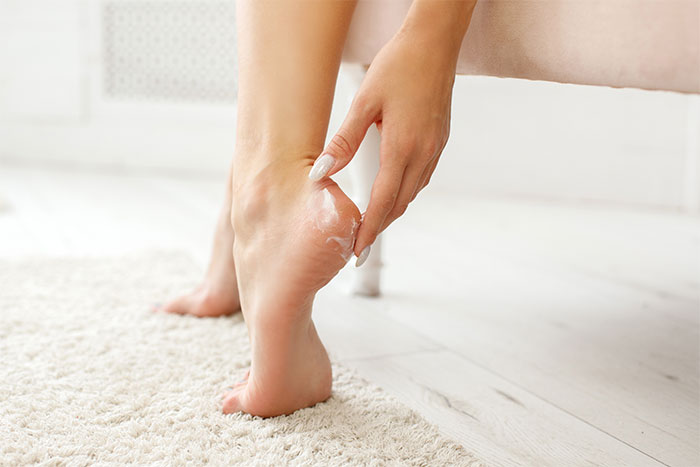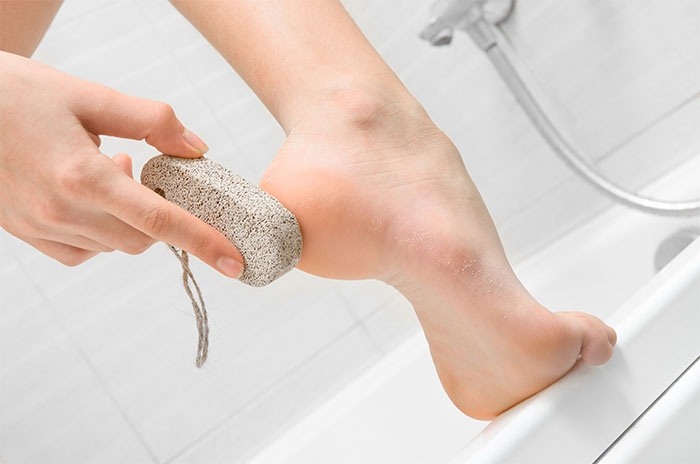Phone: +44 (0)20 8492 1600
Need help or have a question?
Contact us at: [email protected]
| Section | Summary |
|---|---|
| Causes of Dry Feet | Several factors, including age, health conditions, environmental conditions, and lifestyle choices, can cause dry feet. Dehydration, certain medications, and skin conditions like eczema and psoriasis may also lead to this condition. |
| Symptoms Associated with Dry Feet | Dry feet can manifest as rough, hard skin. Other symptoms may include flaky, itchy skin, redness, or even cracking. Severe cases can lead to discomfort and difficulty walking. |
| How to Treat Dry Feet | Treatments for dry feet can include using a Hard Skin Remover or Micro File to remove hard skin. Our Intensive Repair Cracked Heel Cream can provide hydration and promote healing. For flaky skin, Moisturising Foot Socks can help lock in moisture. |
| How to Prevent Dry and Cracked Feet | Prevention methods include maintaining good foot hygiene, regular moisturiing, avoiding extreme temperatures, wearing appropriate footwear, and staying hydrated. |
Feet are among the most vital yet overlooked parts of our bodies, carrying the weight of our daily activities. However, when dry, cracked feet make an appearance, it’s a reminder of how pivotal foot health is to our overall well-being. The discomfort from this condition can hinder our mobility, diminish our quality of life, and potentially indicate more serious health issues. Therefore, attending to dry, cracked feet isn’t solely about aesthetics or superficial comfort, but a matter of general health and vitality.
This guide explores the causes, symptoms, treatment options, and prevention tips for dry feet. From understanding the various conditions associated with this common issue, like dry hard skin, flaky skin, or itchy skin, to utilising specialised products, such as our Intensive Repair Cracked Heel Cream and Moisturising Foot Socks, we provide insight into restoring foot health. Moreover, we delve into practical tips and strategies for preventing dry, cracked feet, emphasising the importance of a regular foot care routine.

There are several reasons that could lead to dry feet. Often, the dry skin on the feet can be attributed to the lack of moisture, but there’s more to it than just this. The environment plays a significant role too – cold weather can lead to dryness while hot, damp conditions may foster fungal growth causing further issues. Wearing tight or poorly ventilated shoes can also exacerbate the problem. Age is another factor as our skin naturally loses elasticity and oil glands with age. Medical conditions like diabetes, hypothyroidism, psoriasis, or dermatitis can also cause dry feet.
Dry feet aren’t just an aesthetic issue but can present discomfort and other symptoms. Typically, dry feet symptoms include itching, redness, flakes, and rough skin. If the skin on the feet becomes too dry, it may crack, potentially leading to dry and cracked feet. In severe cases, these cracks might be deep, causing pain and increasing the risk of infection.
The first step in treating dry feet is to remove the hard skin. You can use a pumice stone or a foot file, such as the Micro-file or 360 foot file, to gently exfoliate the feet. Make sure to soak your feet in warm water for 10-15 minutes before starting the process. This will soften the skin and make it easier to remove the hard skin.
Dry flaky skin on feet can often be treated with the application of moisturising creams and ointments such as our . Choose a product that contains ingredients like urea or lactic acid, which can help to soften and exfoliate the dry skin. Moisturising Foot Socks can be a great addition to your routine, providing deep hydration to your feet.
If your dry feet are also itchy, it could be due to dryness or a fungal infection such as athlete’s foot. If this is the case then use our Athlete’s foot treatment and it will reduce or stop the itchiness. Keep your feet clean and dry, and use a foot cream designed for dry, itchy feet. If the itchiness persists, it may be time to consult your doctor or podiatrist.
Preventing dry and cracked feet is easier than you might think. Here are some steps you can take:

Managing and preventing dry and cracked feet is often achievable with understanding and consistent care. By learning the causes and symptoms of this common condition, you’ll be better equipped to employ effective treatment strategies and preventative measures.
For more information on foot care and dealing with dry skin, we highly recommend taking a look at our articles – Why Do I Get Dry Skin? and Looking After Your Feet: Your Guide to Healthy, Happy Feet. These resources provide more insights into how you should look after your foot health.
However, it’s crucial to remember that while home remedies and over-the-counter products like our Intensive Repair Cracked Heel Cream and Moisturising Foot Socks can provide significant relief, they are not a definitive solution for all cases. If your dry feet symptoms persist despite regular care, or if you notice severe cracks, bleeding, or signs of infection, it’s essential to seek medical advice from a doctor or podiatrist.
Persistent foot problems may be a sign of underlying health issues that need more than superficial treatment. Don’t ignore your symptoms; consider them as signals your body is giving you about its well being. By taking your dry feet symptoms seriously and responding appropriately, you’re not just caring for your feet; you’re looking after your overall health.
Ultimately, managing dry and cracked feet is an ongoing commitment. By combining knowledge, proactive care, and timely intervention, you can enjoy healthier, happier feet – and a more comfortable life.
Various factors, such as age, underlying health conditions, environmental factors, and lifestyle choices, can lead to dry feet. Dehydration, certain medications, and skin conditions like eczema and psoriasis may also contribute to dry feet.
Dry feet typically manifest as rough, hard skin that may be accompanied by flaking, itchiness, redness, or even cracking. In severe cases, these cracks may cause pain and difficulty in walking.
Using a product like our Hard Skin Remover or Micro File can help to gently exfoliate and remove hard skin. Applying a moisturising cream, such as our Intensive Repair Cracked Heel Cream, can also provide much-needed hydration and promote healing.
Keeping your feet clean, dry, and moisturised is key. Our Moisturising Foot Socks can help to lock in moisture and provide relief for dry, flaky skin.
Try to avoid scratching as it can lead to further irritation or infection. Moisturising frequently and using a product designed for dry, itchy skin can help. If the itchiness persists, seek medical advice.
Practicing good foot hygiene, regular moisturising, avoiding extreme temperatures, and wearing appropriate footwear can help to prevent dry, cracked feet. Drinking plenty of water to stay hydrated is also important.